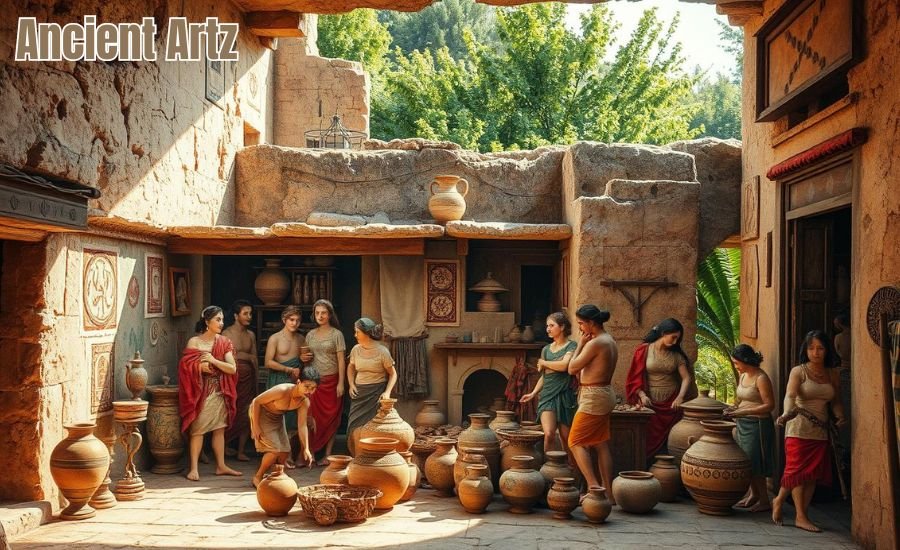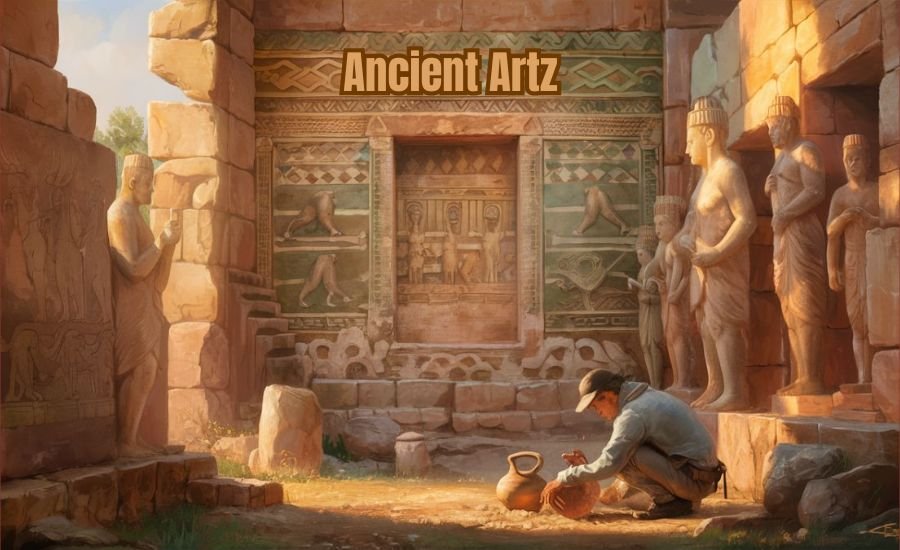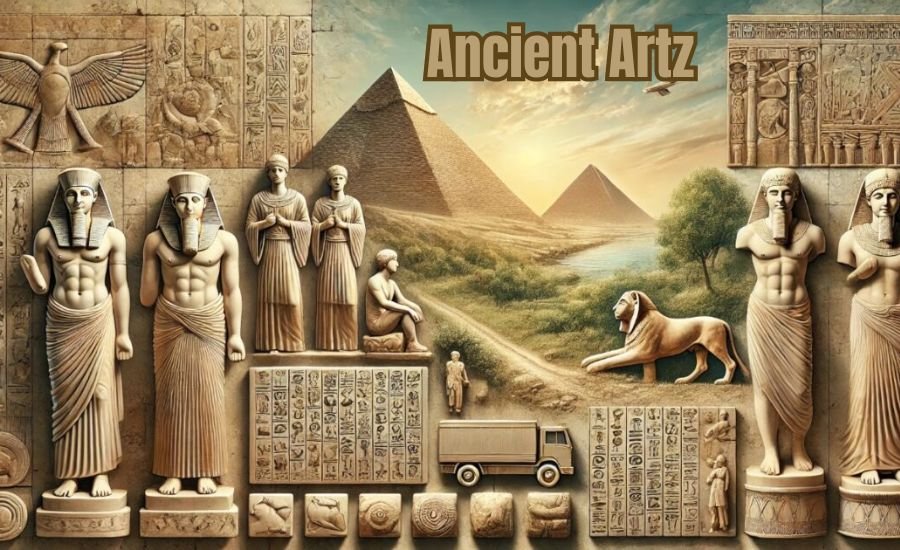Ancient artz is a captivating subject that connects us with the creative expressions of civilizations long gone. This article will delve into various aspects of ancient artz, including its significance, styles, materials, and impact on modern art. Our journey will take us through ancient Egypt, Greece, Rome, India, and China, showcasing how these cultures shaped the art world and continue to inspire today.
Understanding Ancient Artz
Ancient artz refers to the artistic creations produced by societies before the Middle Ages. This term encompasses many works, including sculptures, paintings, pottery, and architecture. Each civilization developed unique artistic styles and techniques, often reflecting their beliefs, daily lives, and environments.
The Purpose of Ancient Artz
The primary purpose of ancient artz was to express cultural identity, commemorate significant events, and document historical narratives. Through these artistic expressions, we gain insight into the values, customs, and experiences of the people who created them.
Cultural Identity
Art is a powerful means of expressing cultural identity. Different civilizations have distinct styles that reflect their histories and values. For instance, the monumental structures of ancient Egypt, the intricate pottery of Greece, and the elegant sculptures of India all showcase the diversity and richness of ancient art.
The Evolution of Ancient Artz
As civilizations progressed, so did their artistic techniques and styles. From the primitive cave paintings of early humans to the sophisticated sculptures of ancient Rome, the evolution of ancient artz mirrors the development of human society itself.
Early Expressions
The earliest forms of ancient artz can be traced back to prehistoric times. Cave paintings, such as those in Lascaux, France, provide evidence of early humans expressing themselves through art. These primitive drawings depict animals and hunting scenes, illustrating the daily life and beliefs of early communities.
Classical Civilizations
As societies became more complex, so did their artistic endeavors. The ancient Egyptians, Greeks, and Romans developed distinct artistic styles that reflected their cultural values and beliefs. Each civilization contributed significantly to the evolution of ancient artz, leaving a lasting legacy that continues to influence modern art.
Major Civilizations and Their Artistic Contributions

Ancient Egypt: The Eternal Legacy
Overview of Egyptian Art
Egyptian art is renowned for its grandeur and intricate details. This civilization flourished for thousands of years, leaving a rich artistic heritage characterized by monumental architecture, vibrant murals, and elaborate sculptures.
Sculptures and Architecture
One of the most iconic aspects of ancient Egyptian artz is its monumental architecture, including the pyramids and temples. These structures were designed to honor the gods and serve as tombs for pharaohs. For example, the Great Pyramid of Giza stands as a testament to the engineering skills and artistic vision of the ancient Egyptians.
Egyptian sculptures often depict pharaohs, gods, and everyday life. The stone statues of the pharaohs convey a sense of power and authority. These works of art were not merely decorative; they served a spiritual purpose, connecting the living with the divine.
Tomb Paintings
Tomb paintings provide a vibrant glimpse into the beliefs and customs of ancient Egyptians. These artworks adorned the walls of tombs and were designed to accompany the deceased in the afterlife. Scenes of daily life, agricultural activities, and rituals were depicted, ensuring the dead would have everything they needed in the next world.
Ancient Greece: The Celebration of Beauty
Overview of Greek Art
Greek art is celebrated for emphasizing beauty, harmony, and the human form. The Greeks significantly contributed to various art forms, especially sculpture and pottery, which inspire artists today.
Pottery
Greek pottery is famous for its detailed narratives and artistic styles. Vases and amphorae often depicted scenes from mythology, daily life, and athletic competitions—the black-figure and red-figure techniques allowed artists to create dynamic stories, showcasing their technical skills and creativity.
The artwork on these vessels served a functional purpose and reflected the cultural values and stories important to ancient Greek society. The intricate designs provide insight into their beliefs, customs, and daily activities.
Sculpture
Greek sculpture reached new heights in the Classical period. Artists such as Phidias and Praxiteles created the perfect human figure, making lifelike sculptures that showcased humanism and the concept of proportion. The Parthenon sculptures, known for their intricate details and dramatic poses, exemplify the artistic mastery of ancient Greece.
The emphasis on human beauty and physical perfection in Greek art influenced later artistic movements and established a foundation for the study of anatomy and proportion in art.
Ancient Rome: A Blend of Influences
Overview of Roman Art
Roman art was heavily influenced by Greek art but adapted to their cultural needs. It is known for its practicality and grandeur, showcasing the power and authority of the Roman Empire.
Architecture
Roman architecture is characterized by monumental structures such as the Colosseum, aqueducts, and basilicas. Their engineering innovations, like the use of arches and concrete, allowed for impressive designs that have endured through the ages. The Roman Pantheon’s massive dome and oculus exemplify their architectural prowess.
Mosaics
Mosaics were a popular art form in ancient Rome, often found in public buildings and private homes. The exquisite artworks, made out of tiny fragments of glass or stone, depicted mythological images of nature and everyday life. Roman mosaics added color and vibrancy to the spaces they adorned, demonstrating the skill and creativity of ancient artists.
Ancient India: A Spiritual Journey
Overview of Indian Art
Ancient Indian art fuses cultural and religious influences, particularly from Hinduism and Buddhism. Its artistic expressions reflect the deep spiritual beliefs and rich traditions that shaped Indian society.
Rock-Cut Caves
The caves cut from the rock at Ajanta and Ellora exhibit exquisite artifacts and frescoes telling religious stories. These intricate artworks demonstrate ancient artisans’ technical skill and devotion, creating spaces for worship and meditation.
Temple Architecture
Indian temples are known for their elaborate carvings and sculptures depicting deities and mythological narratives. The intricate designs and architectural styles reflect the spiritual life of the culture, inviting worshippers to connect with the divine.
Ancient China: A Rich Cultural Heritage
Overview of Chinese Art
The Chinese artistic heritage is diverse and deeply interwoven with its philosophical and social values. Ancient Chinese art encompasses various forms, including painting, calligraphy, ceramics, and sculpture.
Calligraphy
Calligraphy is considered one of the highest forms of art in China. The beauty of written characters reflects this practice’s skill and cultural significance. It is often used in poetry and scholarly works. Calligraphy conveys the meaning of words and the artist’s emotions and thoughts, making it a deeply personal expression.
Pottery and Porcelain
Chinese pottery, particularly during the Han and Tang dynasties, was admired for its high-end craftsmanship and quality. The growth of porcelain during the Tang dynasty was a major improvement in the art of ceramics, creating works of art that remain cherished to this day. Chinese porcelain is known for its delicate beauty and intricate designs, often depicting natural scenes and mythical creatures.
The Role of Religion in Ancient Artz

Spiritual Significance
Religion played a pivotal role in shaping ancient art across cultures. Many artworks were created for religious rituals, reflecting society’s values and beliefs. Elaborate temple carvings, detailed sculptures of deities, and vibrant murals often served both aesthetic and spiritual purposes.
Ritual and Ceremony
Art was often intertwined with rituals. Specific artworks were created for ceremonies, such as masks used in Native American rituals or the intricate paintings found in Buddhist temples. These works of art added depth and meaning to the rituals, enhancing the spiritual experience for participants. The connection between art and religion can be seen in several ways:
- Sacred Spaces: Temples and altars adorned with artistic representations of deities served as places for worship and connection with the divine.
- Ceremonial Objects: Items like ritual masks, vessels, and offerings often featured intricate designs that held spiritual significance.
- Narrative Art: Many artworks depicted religious stories and myths, educating viewers about their faith and cultural beliefs.
Art as Propaganda
Ancient rulers often used art in their attempts to establish control and aplomb. Monumental statues, grand public buildings, and intricate reliefs were designed to impress both subjects and foreign visitors. The artworks conveyed messages of strength, stability, and divine favor, reinforcing the ruler’s status and the greatness of their empire.
Hope you find this interesting: Ancient Grain in a Healthy Cereal NYT
Preservation and Appreciation of Ancient Artz
Archaeological Discoveries
The ongoing excavations of archaeological sites continue to unearth ancient works of art that enrich our knowledge of ancient civilizations. Locations such as Pompeii and the Valley of the Kings reveal hidden treasures that tell us about old times and the cultures of the past. Each discovery adds a piece to the puzzle of our understanding of ancient art and its significance.
Restoration Efforts
Preserving ancient art is essential for future generations. Many artifacts are under threat from humans and environmental elements. Conservationists are dedicated to protecting and preserving these important objects of art. Restoring ancient artworks requires careful techniques to maintain authenticity while ensuring longevity.
Museums and Exhibitions
Museums are crucial in preserving ancient art and making it accessible. Exhibitions featuring ancient artworks allow people to appreciate the beauty and significance of these creations, fostering a deeper understanding of our shared heritage. Many museums also offer educational programs and resources to help visitors learn about ancient Artz.
The Lasting Impact of Ancient Artz
Influence on Modern Art
The influence of art from the past remains evident in modern methods. Modern artists often draw ideas and concepts from the past. The Renaissance of the classical arts during the Renaissance shows how the ancient techniques still resonate today in art forms.
Cultural Awareness
Studying ancient artz fosters cultural awareness and appreciation for diversity. By understanding the artistic achievements of different civilizations, we can celebrate the richness of human creativity and the shared experiences that connect us all.
Artistic Innovation
Ancient art inspires innovation in modern art. Artists often reinterpret ancient themes, materials, and techniques, creating new works that honor the past while pushing the boundaries of contemporary creativity.
Conclusion
Ancient artz is a rich tapestry of human creativity and cultural expression. It provides valuable insights into the lives and beliefs of our ancestors, reminding us of the shared heritage that binds us all. By exploring the diverse styles, materials, and techniques of ancient artz, we celebrate the achievements of past civilizations and inspire future generations to continue the journey of artistic expression.
Final Thoughts
As we delve into ancient artz, we discover these creations’ timeless beauty and enduring significance. They remind us of the power of art to connect us across time and space, fostering a greater understanding of our shared human experience. Through continued exploration and appreciation of ancient artz, we can enrich our lives and honor the creativity of those who came before us.
FAQs
Q: What are ancient artz?
A: Ancient Artz refers to artistic creations from ancient civilizations, including sculptures, paintings, pottery, and architecture, reflecting cultural beliefs, practices, and societal values.
Q: Why is ancient artz important?
A: Ancient artz is essential because it provides insight into the history, culture, and daily life of past societies, helping us understand their beliefs, values, and artistic techniques.
Q: What materials were used in ancient Artz?
A: Artists in ancient times used various materials, including stone, clay, metal, wood, and pigments from natural sources, depending on the region and available resources.
Q: How did religion influence ancient artz?
A: Religion significantly influenced ancient Artz by inspiring the creation of artworks for rituals and ceremonies and as representations of deities, serving both spiritual and educational purposes.
Q: What is an example of ancient artz?
A: An example of ancient art is the Parthenon in Greece. It is a temple dedicated to the goddess Athena, featuring intricate sculptures and detailed reliefs that celebrate her importance in Greek culture.
Q: How can we study ancient artz today?
A: We can study ancient artz through archaeological excavations, museum collections, and scholarly research, analyzing the artworks to uncover their historical and cultural significance.
Q: Are there modern influences in ancient artz?
A: Yes, many modern artists draw inspiration from ancient artz, incorporating traditional techniques, themes, and motifs into contemporary works, bridging the gap between past and present.
Stay in touch to get more updates on TECH DENSER




